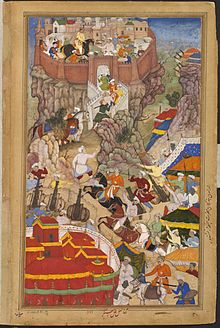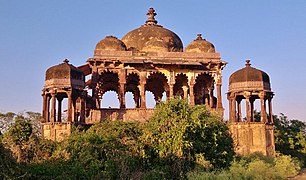| This article needs additional citations for verification. Please help improve this article by adding citations to reliable sources. Unsourced material may be challenged and removed. Find sources: "Ranthambore Fort" – news · newspapers · books · scholar · JSTOR (June 2013) (Learn how and when to remove this message) |
| Ranthambore Fort | |
|---|---|
 Ranthambore Fort in Sawai Madhopur, Rajasthan, India Ranthambore Fort in Sawai Madhopur, Rajasthan, India | |
| Type | Fortress |
| Location | Sawai Madhopur, Rajasthan, India |
| Coordinates | 26°1′13″N 76°27′18″E / 26.02028°N 76.45500°E / 26.02028; 76.45500 |
| Area | 102 ha (0.39 sq mi) |
| Built | 5th Century CE |
| UNESCO World Heritage Site | |
| Type | Cultural |
| Criteria | Cultural: (ii)(iii) |
| Designated | 2013 (37th session) |
| Part of | Hill Forts of Rajasthan |
| Reference no. | 247 |
| ID | 247rev-003 |
| Region | Asia and the Pacific |
| Buffer Zone | 372 ha (1.44 sq mi) |
  | |
Ranthambore Fort lies within the Ranthambore National Park, near the city of Sawai Madhopur in Sawai Madhopur district of Rajasthan, India. The park being the former hunting grounds of the Maharajas of Jaipur until the time of India's Independence. It is a formidable fort having been a focal point of the historical developments of Rajasthan. The Ranthambhore fort is believed to have been built during the 5th century by Yadavas ruler Maharaja Jayant. The Yadavas king ruled over it until they got expelled by Prithviraj Chauhan in 12th century. The fort was occupied by Sultans of Delhi. Later on, It came under control of Merwar and Mughals.The fort provides a panoramic view of the surrounding Ranthambore National Park and is now a popular tourist attraction.
The fortress commanded a strategic location, 700 feet above the surrounding plain. In 2013, at the 37th session of the World Heritage Committee held in Phnom Penh, Cambodia, Ranthambore Fort, along with 5 other forts of Rajasthan, was declared a UNESCO World Heritage Site under the group Hill Forts of Rajasthan.
History
Under Chauhans Rajputs
See also: Chahamanas of RanastambhapuraIts earlier name was Ranastambhapura (Sanskrit: Raṇa-sthaṃba-pura, "City of the Battle Post"). It was associated with Jainism during the reign of Prithviraja I of Chahamana (Chauhan) dynasty in the 12th century. Siddhasenasuri, who lived in the 12th century has included this place in the list of holy Jain tirthas. In the Mughal period, a temple of Mallinatha was built in the fort.
After the defeat of Prithviraja III (Prithviraj Chauhan) in 1192 CE, the fort came under the control of the Muslim Ghurid ruler Muhammad of Ghor.
The Delhi Sultan Iltutmish captured Ranthambore in 1226, but the Chauhans re-captured it after his death in 1236. The armies of Sultan Nasiruddin Mahmud, led by the future Sultan Balban, unsuccessfully besieged the fortress in 1248 and 1253, but captured from Jaitrasingh Chauhan in 1259. Shakti Dev succeeded Jaitrasingh in 1283, and recaptured Ranthambore and enlarged the kingdom. Sultan Jalal ud din Firuz Khalji briefly besieged the fort in 1290-91 but was unsuccessful in capturing it. In 1299, Hammiradeva sheltered Muhammad Shah, a rebel general of Sultan Ala ud din Khalji, and refused to turn him over to the Sultan. The Sultan besieged and conquered the fort in 1301.

Under Mewar
The fortress was captured by various kings of Mewar. Ranthambore was under the direct rule of Rana Hamir Singh (1326–1364), Rana Kumbha (1433–1468) and Rana Sanga (1508–1528).
Under Hadas

During Rana Udai Singh I's reign (1468–1473) the fortress passed to the Hada Rajputs of Bundi. Sultan Bahadur Shah of Gujarat briefly captured the fortress from 1532 to 1535. The Mughal Emperor Akbar captured the fortress in Siege of Ranthambore (1568) from Hadas.
Under Jaipur
The fortress passed to the Kachwaha Maharajas of Jaipur in the 17th century, and it remained part of Jaipur state until Indian Independence. The area surrounding the fortress became a hunting ground for the Maharajas of Jaipur. Jaipur state acceded to India in 1949, becoming part of the state of Rajasthan in 1950.
Temples
Inside Ranthambore fort, there are three Hindu temples dedicated to Ganesha (Trinetra Ganesha), Shiva and Ramlalaji constructed in 12th and 13th centuries from red Karauli stone. The Ganesha temple is particularly famous and attracts thousands of visitors every Wednesday. There is also a Jain temple of Lord Sumatinath (5th Jain Tirthankar) and Lord Sambhavanath.
Nearby attractions
Most of the attractions listed below is not open to the public since it falls under the Project Tiger Protected Area. It can be viewed from vehicles authorized and booked for wildlife safaris only. It is also accessible to people descended from the villagers that were relocated outside the park.
- Water gateways
- Kachida Valley
- Surwal Lake
- Sitla Mata
- Picnic sports
- Malik Talao
- Wild life
- Bakula
- Lakarda And Anantpura
- Rajbagh Talao
- Ranthambore National Park
- Historical places
- Jogi Mahal
- Padam Talao
- Raj Bagh Ruins
- Ranthambhore Fort
- Ranthambhore School Of Art
- Ganesha temple
- Jain Temple
Gallery
-
The way inside the fort
-
History of Ranthambore Fort written on the wall
-
 Jain temple at Ranthambore Fort
Jain temple at Ranthambore Fort
-
 Battees Khamba
Battees Khamba
-
 Annapurna Temple
Annapurna Temple
-
 Fine rock art at Ranthambhore Fort
Fine rock art at Ranthambhore Fort
-
 Old tomb, Ranthambore Fort
Old tomb, Ranthambore Fort
-
 Rani Haveli
Rani Haveli
-
 Ranthambore Fort Jain Temple
Ranthambore Fort Jain Temple
-
Entrance
-
 Naulakha Gate, Ranthambhore Fort
Naulakha Gate, Ranthambhore Fort
See also
- Hill Forts of Rajasthan
- Chamatkarji
- Sawai Madhopur District
- Sawai Madhopur
- Rajiv Gandhi Regional Museum of Natural History
- Shilpgram, Sawai Madhopur
- Sawai Madhopur railway station
References
- Anil K., Tiwari (12 December 2023). "Ranthamhor Fort | Archaeological Survey of India Jaipur Circle". Archeological Survey of India. Retrieved 6 April 2024.
- R.P.Meena (25 January 2019). RPSC RAS Mains 2019 Practice Solved Test Paper. R P Meena.
- Adhikari, Subhrashis (20 April 2016). The Journey of Survivors: 70,000-Year History of Indian Sub-Continent. Partridge Publishing. ISBN 978-1-4828-7334-4.
- Team, YCT Expert. Mechanical Engineering. Youth Competition Times.
- "UNESCO World Heritage". Archived from the original on 28 February 2018. Retrieved 27 February 2018.
- Aditya Malik (2021). Hammīra: Chapters in Imagination, Time, History. Religion and Society. Vol. 83. De Gruyter. p. 19. ISBN 978-3-11-065959-7.
- Singh, Narendra (1 January 2001). Encyclopaedia of Jainism. Vol. 1. Anmol Publications / Indo-European Jain Research Foundation. p. 5538. ISBN 978-81-261-0691-2.
- Dasharatha Sharma (1959). Early Chauhān Dynasties. S. Chand / Motilal Banarsidass. p. 102. ISBN 9780842606189. Archived from the original on 3 July 2023. Retrieved 6 October 2016.
- Khan, Iqtidar Alam (25 April 2008). Historical Dictionary of Medieval India By Iqtidar Alam Khan pg 126. Scarecrow Press. ISBN 978-0-8108-6401-6. Archived from the original on 14 August 2023. Retrieved 14 March 2023.
- IA, Vol. XLII, pp. 57-64
- Mishra, Shyam Manohar (1977). Yasovarman of Kanau, p.123. Archived from the original on 29 May 2022. Retrieved 25 September 2012.
External links
 Ranthambore Fort travel guide from Wikivoyage
Ranthambore Fort travel guide from Wikivoyage- Ranthambore National Park : A comprehensive guide
| Forts in Rajasthan | |
|---|---|